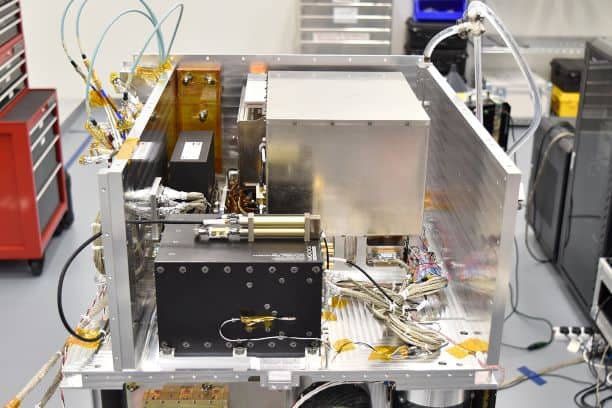Stable ticker: The payload of the Deep Space Atomic Clock mission, which launched in 2019, includes an atomic clock, a GPS receiver, and an ultra-stable oscillator. (Courtesy: NASA)”>
A compact atomic clock that has orbited the Earth since 2019 is far more stable than previous space-based clocks, raising hopes that future spacecraft will be able to keep track of time autonomously. Although technical problems have limited the new trapped-ion device’s performance, the US-based scientists who developed it report that it is reliable enough to substantially reduce the need for back-and-forth communication with controllers on the ground, thereby improving navigation.
Stability is a fundamental attribute of good timekeeping. If a clock is unstable on short timescales, the delay from one tick to the next fluctuates and its output must be averaged to achieve the desired precision. If the clock’s output drifts on longer timescales, it needs to be periodically corrected by a more stable device.
This is the situation for the atomic clocks on board today’s global positioning satellites. These clocks allow each satellite to keep track of both time and position, which in turn enables users on the ground to navigate through triangulation. However, because they experience drift, their recorded time must be very slightly tweaked each day to bring it into line with stabler (but also bulkier and more complex) atomic clocks on the ground.
In the latest research, John Prestage, Robert Tjoelker, Eric Burt and colleagues at the Jet Propulsion Laboratory (JPL) in the California Institute of Technology built a clock that is small and rugged enough to withstand the harsh conditions of space yet also stable enough to operate independently. Such a device, they say, would not only make terrestrial satellite systems more autonomous, it should also allow deep-space probes to navigate in close to real-time.
Clock workings
At the core of the clock is a vacuum tube containing two cylindrical traps, each measuring a little over a centimetre in diameter. The first trap is used to load and prepare a small cloud of several million mercury-199 ions, while the second measures the ions’ “ticking”. Both traps generate electric fields to hold the ions in place and prevent them from colliding with the trap walls, which would cause the clock’s signal to drift.
Mercury-199 ions have a “clock” transition at 40.5 GHz that is insensitive to magnetic fields – a useful feature given the high and fluctuating magnetic fields in space. This transition is used to lock the output of a quartz crystal. A frequency synthesizer referenced to this crystal generates microwaves and is tuned to around 40.5 GHz, while a plasma discharge lamp produces ultraviolet light that further raises the energy level of the ions if they have already been excited by the microwaves. The fluorescence these ions generate when they promptly re-release the ultraviolet energy therefore indicates that the oscillator is at the correct frequency.
Time to fly
Researchers at JPL have been working on trapped-ion clock technology since the 1980s and have obtained excellent results in their laboratory, achieving a short-term stability of 2×10−14/τ1/2 (τ being the averaging time) and drifts as low as 2.7×10−17 per day. What’s more, they have done so without using lasers, cryogenics or microwave cavities, all of which would introduce unwelcome complications for space-based clocks.
With these results in the bag, NASA approved the Deep Space Atomic Clock mission in 2011. Under the leadership of principal investigator Todd Ely, the mission team produced a microwave-oven sized clock that was launched into a 720-km altitude orbit in June 2019 alongside other experiments.
Although the clock has now kept time for almost two years, the mission hasn’t been trouble-free. A problem with levels of neon gas used to cool the ions means the scientists have had to measure the clock frequency with the loading trap, which was not designed to make such measurements. This fault affected the clock’s performance, but Prestage and colleagues nevertheless recorded a short-term stability of 7×10−13/τ1/2, a long-term stability of 3×10−15 and an estimated drift of 3×10−16 per day, all without controlling the temperature of the apparatus. The drift result, they say, is better than that of existing satellite-based atomic clocks by around an order of magnitude.
Deep space or bust
The researchers argue that this level of performance is already good enough for autonomous timekeeping. That, in turn, means that future spacecraft equipped with such a clock would need only a single communication link with ground controllers – to receive their timing and positioning data – rather than the three links currently required. The researchers add that the clock might also aid Solar System exploration – making it possible, for example, to plot the gravitational field of Jupiter’s moon Europa to see if there might be an ocean under its icy crust.

Atomic clocks in space could detect gravitational waves
Looking ahead, the researchers say they are trying to extend the lifetime of their clock technology from up to five years to at least a decade. Among other things, this will mean working out how to improve the ultraviolet light source and optimize the pressure inside the vacuum chamber so as to lose less neon gas.
However, not everyone is convinced. Liang Liu of the Shanghai Institute of Optics and Fine Mechanics in China, who heads a cold-atom clock experiment that has been in orbit since 2016, welcomes the NASA project but finds its long-term stability of around 3×10−15 per day underwhelming. “For deep space navigation, we might need 10-16 or better,” he says.
The research is reported in Nature.
